 |
 |
 |
| |
Impact of Sustained Virologic Response with Direct-Acting Antiviral Treatment on Mortality and Hepatocellular Carcinoma - significantly lower mortality, HCC 60% to 84%
|
| |
| |
Reported by Jules Levin
AASLD: The Liver Meeting® 2017, October 20-24, 2017, Washington, DC
L. Backus, P.S. Belperio, T.A. Shahoumian, L.A. Mole Population Health Services, Veterans Affairs Palo Alto Health Care System, Palo Alto, California
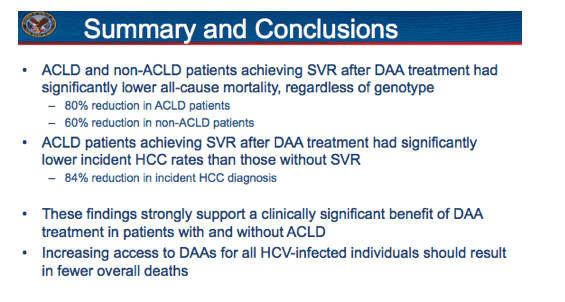
Successfully treating HCV before the development of advanced liver disease translates into a significant mortality benefit.
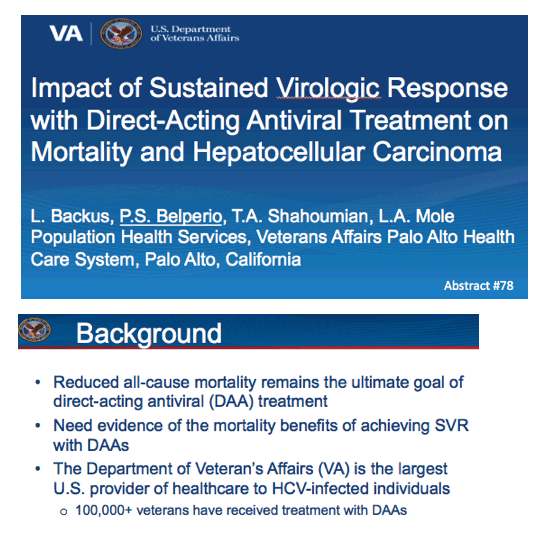
Hepatitis C virus (HCV) antiviral treatment effectiveness is assessed by the surrogate end point of sustained virologic response (SVR), however, reduced all-cause mortality remains the ideal marker of treatment benefit and the ultimate goal.
In light of Cochrance Review, need for evidnece of mortality benefit of DAAs
The large number of veterans treated in VA - both with and without ALD make VA an ideal setting to examine these important outcomes
Second, the long-term care integration affords the opportunity to follow up on individual patient outcomes over time
thirdly, there is national VA guidance and treatment considerations in place which apply to all VA facilities providing some consistency in the general management and use of DAAs across its population.
Fourth, VA has not had restrictions on specific populations of patients that can or cannot receive DAA treatment,
Lastly, the diverse real-world population treated within VA allows for examination of the impact of comorbidities on all-cause mortality after DAA treatment.
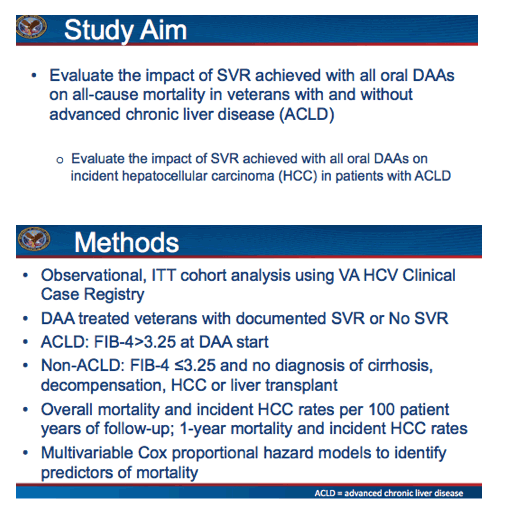
This observational cohort analysis used data from the VA's Clinical Case Registry for HCV, an extract of the VA's electronic medical record for all HCV-infected veterans receiving care at VA medical facilities.
Overall mortality rates were calculated as deaths per 100 years of patient follow-up. In addition, since follow-up is relatively limited given the recent introduction of DAAs and it is possible that the mortality rate changes over time, one-year mortality rates were also determined. The one-year mortality rates were calculated as the number of deaths within one year of the EOT among those people who stopped treatment by May 31, 2016 so there was at least one year of follow-up on all included patients.
Multivariable Cox proportional hazard models were constructed to identify predictors of mortality and the impact of SVR
The one-year mortality rates were calculated as the number of deaths within one year of the EOT among those people who stopped treatment by May 31, 2016 so there was at least one year of follow-up on all included patients.
Kaplan-Meier curves of survival and of HCC-free survival by SVR were compared with log-rank tests. Mortality and incident HCC rates per 100 patient years of follow-up were compared with the Exact Poisson test. One-year mortality and HCC rates were compared with proportion tests. Cox proportional hazard models were constructed to identify predictors of mortality and the impact of SVR.
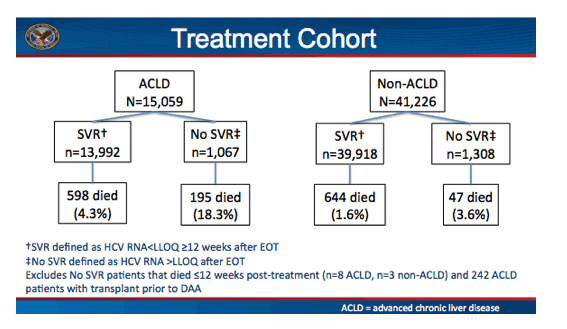
ACLD - Among No SVR patients, 195 died during a mean follow-up period of 1.5 years after EOT. Among SVR patients, 598 died during a mean follow-up period of 1.6 years after the EOT.
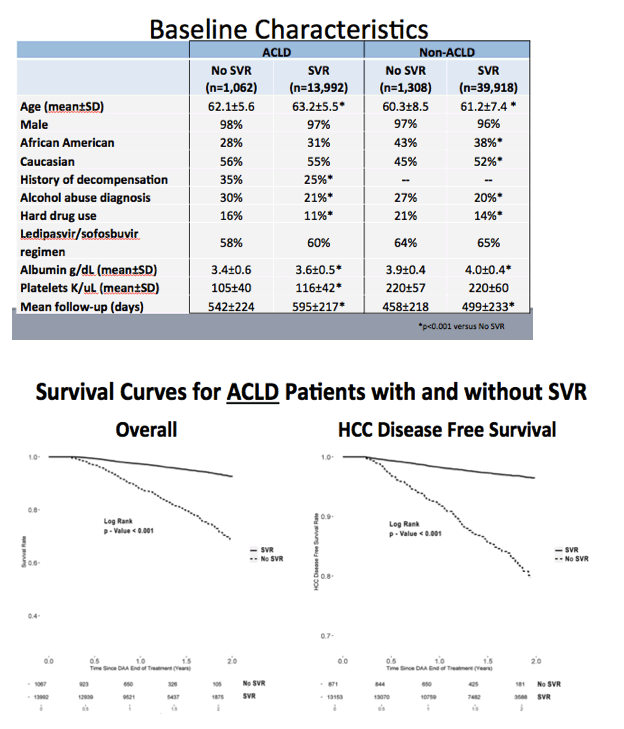
As seen by KM curves In unadjusted analysis, SVR was associated with statistically significantly reduced all-cause mortality compared to No SVR (p<0.001)(Figure 1). The cumulative mortality curves for No SVR and SVR diverged early in the follow-up period and the reductions in all-cause mortality among SVR patients appear clinically significant.
SVR was strongly associated with delayed time until development of HCC
Kaplan-Meier curves of survival and of HCC-free survival by SVR were compared with log-rank tests.
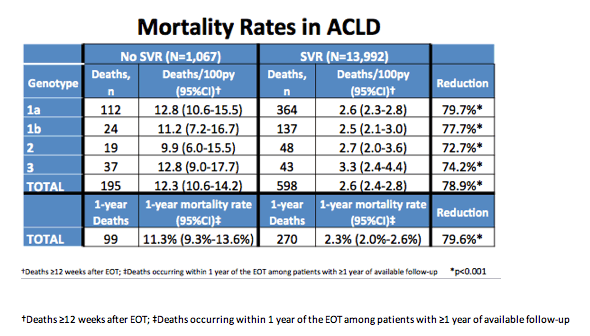
Deaths ≥12 weeks after EOT; Deaths occurring within 1 year of the EOT among patients with ≥1 year of available follow-up
Among 15,059 ACLD patients, 195/1,067 with No SVR and 598/13,992 with SVR died over a mean follow-up period of
1.6 years; When considering deaths per 100 patient years of follow-up, SVR was associated with a 78.9% reduction in mortality. The percentage reductions across genotypes 1a, 1b, 2 and 3, were similar .
A similar pattern of significantly reduced mortality associated with SVR was evident when considering one-year mortality rates. SVR was associated with a 79.6% reduction
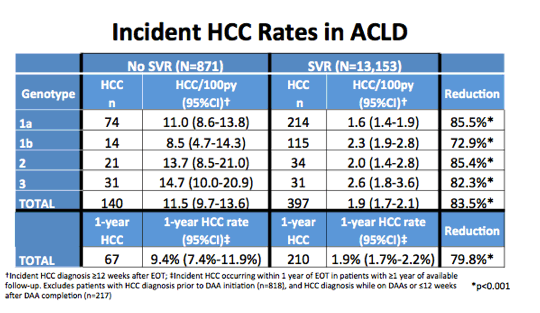
Incident HCC diagnosis ≥12 weeks after EOT; Incident HCC occurring within 1 year of EOT in patients with ≥1 year of available follow-up. Excludes patients with HCC diagnosis prior to DAA initiation (n=818), and HCC diagnosis while on DAAs or ≤12 weeks after DAA completion (n=217)
During follow-up, 140 of 871 No SVR patients and 397 of 13,153 SVR patients had a first diagnosis of HCC.
When considering HCC per 100 patient years of follow-up, SVR was associated with an 83.5% reduction in incident HCC. A similar reduction associated with SVR was evident when considering one-year HCC rates.
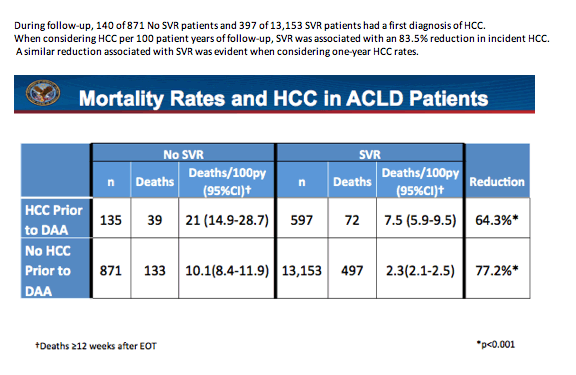
There were 732 patients who had HCC first diagnosed within five years before the start of DAA; 135 were No SVR of whom 39 died in follow-up and 597 were SVR of whom 72 died in follow-up. The death rate for those with prior HCC and No SVR was 21.0 deaths/100 patient years (95%CI 14.9-28.7) compared to 7.5 deaths/100 patient years (95%CI 5.9-9.5) for those with prior HCC and SVR - a 64.3% reduction in the death rate .
For those without a diagnosis of HCC prior to DAA, 871 were No SVR of whom 133 died in follow-up and 13,153 were SVR of whom 497 died in follow-up. Deaths rates for those without prior HCC and No SVR were 10.1 deaths/100 patient years (95%CI 8.4-11.9) compared to 2.3 deaths/100 patient years (95%CI 2.1-2.5) for those without prior HCC and SVR - a 77.2% reduction in the death rate (p<0.001).
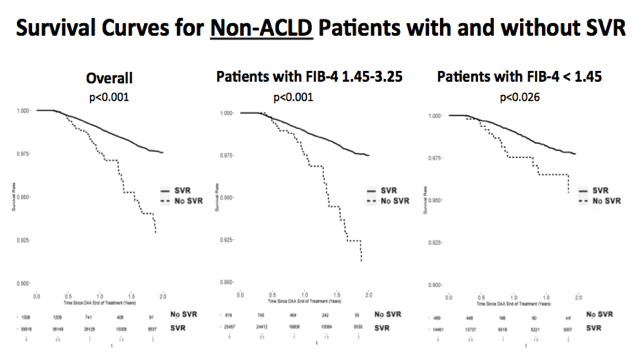
In unadjusted analysis displayed in the Kaplan Meier survival curves, SVR was associated with statistically significantly reduced all-cause mortality compared to No SVR (Figure 1A). When examined separately for patients with FIB-4 <1.45 and 1.45-3.25, SVR was also associated with reduced all-cause mortality compared to No SVR although the statistical significance of the effect was reduced for those with FIB-4<1.45 (Figure 1B and 1C).
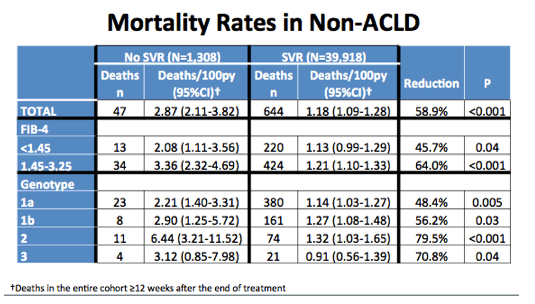
When considering deaths per 100 patient years of follow-up, SVR was associated with a 58.9% reduction in mortality . For patients with FIB-4 <1.45 and 1.45-3.25, SVR was associated with a significant 45.7% and 64.0% reduction in mortality respectively. The percentage reductions across genotypes ranged from a 48.4% reduction for genotype 1a to a 79.5% reduction for genotype 2. (Not Shown, When considering one-year mortality rates, the mortality rate was significantly lower for those with SVR than those with No SVR
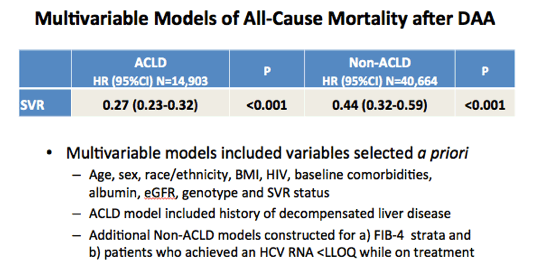
presents the hazard ratios (HR) for death from multivariable Cox proportional hazard models for patients with and without advanced liver disease treated with DAAs.
a Reduced risk of all-cause mortality occurred with achievement of SVR compared to No SVR in BOTH ACLD and Non-ACLD patients while controlling for numerous baseline demographic and clinical characteristics listed.
In ACLD , patients with a history of decompensated liver disease had an increased risk of death. Each 1 g/dL decrease in albumin was also independently associated with increased risk of death.
Non ACLD Models included variables selected a priori of age, sex, race/ethnicity, BMI, other baseline comorbidities, albumin, eGFR, and SVR status. Additional sensitivity models were constructed: including a variable for genotype for the most common genotypes (1a, 1b, 2 and 3), separately for patients with each of these genotypes, limited to patients with FIB-4 <1.45, limited to patients with FIB-4 1.45-3.25, and as indicators of adherence, limited to patients who had at least a 2 log decrease in HCV RNA while on treatment and limited to patients who achieved an HCV RNA below the limit of quantification while on treatment.
ACLD Models included variables selected a priori of age, sex, race/ethnicity, BMI, history of decompensated liver disease, HIV, other baseline comorbidities, albumin, eGFR, and SVR status. Additional multivariable sensitivity models were constructed: using age, albumin and eGFR as categorical variables, including a variable for genotype for the four most common genotypes, separately for patients with each of the four most common genotypes, separately for patients with and without a history of decompensated liver disease, limited to patients who achieved SVR, and limited to those with No SVR. A final multivariable Cox model considered a composite outcome of death or liver transplant in follow-up.
|
| |
|
 |
 |
|
|